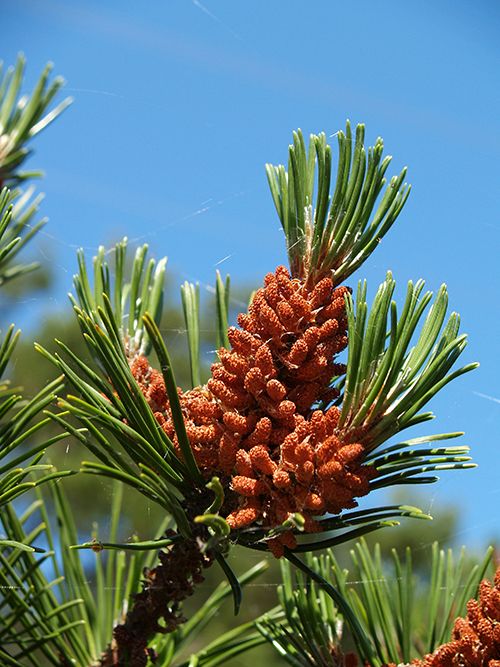On The Trail of The Lonesome Pine
The Column spoke to Linda Schreiner and Andrea Buettner of the Fraunhofer Institute for Process Engineering and Packaging IVV and the Friedrich-Alexander-Universität Erlangen-Nürnberg in Germany, about their work investigating Scots pine for odour-active compounds using two‑dimensional gas chromatography (2D-GC).
Photo Credit: vodolej /stock.adobe.com

The Column spoke to Linda Schreiner and Andrea Buettner of the Fraunhofer Institute for Process Engineering and Packaging IVV and the Friedrich-Alexander-Universität Erlangen-Nürnberg in Germany, about their work investigating Scots pine for odour-active compounds using twoâdimensional gas chromatography (2D-GC).
Q. Why did you decide to investigate Scots pine (Pinus sylvestris L.) for odourâactive compounds?
Andrea Buettner: We wanted to find out what odour-active compounds are present in untreated wood samples, including Scots Pine (1). Scots pine is a very common tree in German forests and it is often used in the production of furniture or flooring. Consequently, its odour is in contact with humans because they are regularly exposed to it, especially in indoor environments.
We also wanted to investigate cedar, which is commonly used for the production of pencils and oak wood. Oak wood is widely used for barrels in wine and whiskey ageing.
Q. What analytical challenges did you encounter and how did you overcome them?
Linda Schreiner: A particular analytical challenge was the high amounts of resin acids and terpenoic substances present in the wood samples. Many of them are not odour-active themselves but covered the interesting odour-active regions of the chromatograms. Using two-dimensional gas chromatography (2D-GC) helped us to separate those substances from the odorants we wanted to target.
Nevertheless, it is still a major challenge to obtain sufficient mass spectrometric data that allows the chemical nature of the respective compound of interest to be predicted. Moreover, many substances, especially terpenoid or sesquiterpenoid substances, are characterized by very similar fragmentation patterns in the mass spectrometer. It was therefore necessary to perform quite challenging detective analytics; combining analytical information such as the specific retention index during chromatography, the characteristic smell, and the MS data helped to reveal the nature of unknown compounds. However, in some cases it was necessary to support this by tedious synthetic chemistry, synthesizing numerous molecules to finally confirm the chemical identity of the unknown odorant. That is part of the charm of sensory analytics-being an investigator and separating and identifying even the smallest traces of an odorant.
Q. What are the next steps to be taken with these results?
LS: Now that we know the main odorants responsible for the smell of Scots pine wood, we will perform analyses to quantify these compounds and thereby gain a clearer picture of the overall odorant composition of the wood. In addition, we are interested in the physiological effects that those wood odours may have on humans. With regard to technological processes, we want to find out how processing steps might influence the characteristic smell of wood, and how these processes can be optimized in order to achieve pleasant and balancing effects of wood smell on humans.
Q. Of the five compounds that were not identified, are there any plans to investigate these in the future?
AB: There were two odours with androstenone-like smells. These are very interesting because androstenone has been reported to not only be odorous but also act as a pheromone in the animal kingdom; specifically, boar taint is associated with androstenone, and this substance also plays a role in pigâmating behaviour. Substances that might be structurally related to this compound but of a plant origin are scientifically interesting but are yet to be resolved. We will work on further resolving odorants that currently remain unknown, and we have several plans to utilize other analytical means to clarify the nature of such compounds.
Q. Could you offer advice to anyone who is thinking of using twoâdimensional gas chromatography in their analytical work?
LS: In the context of odour research, using advanced separation techniques such as two-dimensional gas chromatography is a must. In complex sample matrices such as wood or polymers, often ultratrace amounts of highly potent odorants cause very intense smells, yet these are often concealed by large amounts of non-smelling substances. Therefore, performing a separation on two GC columns is essential to be able to identify the odorant. Of course, working with twoâdimensional systems is more complex than working with one-dimensional systems, but it pays off in the long run. Our research group not only focuses on investigating smells, but also on educating students. In this respect, we train students in the course of their curriculum to become acquainted with methods that are of use for resolving complex mixtures of diverse chemical structures and trace compounds. Moreover, we offer training services to partners from other research organizations and the industry. In several cases, we also developed custom-made sensory analysis toolkits for our partners and perform on-site training, thereby optimizing our partner’s systems or setting up methodologies that are required by our partners.
Q. What other materials could this method be used to investigate?
AB: The method was originally developed for food aroma analysis to investigate the aroma of all manner of foods with the aim of optimizing recipes or processes to improve food flavours. In our group we transferred this method and optimized it for non-food matrices and started investigating diverse products such as wood samples, glues, and paints, as well as plastic materials, such as children’s toys, plastic waste, and recycled materials. We have found that many products are not only heavily contaminated with odorous substances, but that these compounds are of a diverse chemical nature that arises from manifold formation pathways or sources of origin. Moreover, we learned that particularly unpleasant or intense smells often indicate potential hazards. In massâproduced or discount products, we often find an abundance of odorous and often physiologically critical substances, such as alkylated naphthalenes. In some cases, we have discovered molecules that have not even been reported before (2,3)! That means that we not only find novel and odorous substances, but our research also aims at raising awareness of smells in the modern world that often go unnoticed, not because they are not recognizable but because people believe that modern products simply need to smell like that and typically never question whether such products might contain hazardous compounds. In Germany, at least, consumers believe that everything is well controlled with regard to potential risks. However, the reality is that this is not the case and we lack the respective information on what might be present in the abundance of products available on the market. Accordingly, we are interested in examining everything that smells and especially those smells where the causative substances have not yet been identified.
References
- L. Schreiner, P. Bauer, and A. Buettner, Scientific Reports 8, 8284 (2018).
- C. Wiedmer et al., Scientific Reports7, 1807 (2017).
- C. Wiedmer and A. Buettner, Analytical and Bioanalytical Chemistry410, (2018).
Linda Schreiner studied food chemistry at Friedrich-Alexander-Universität Erlangen- Nürnberg (FAU), Germany. She is currently undertaking a Ph.D. at the Fraunhofer Institute for Process Engineering and Packaging IVV and FAU, Germany, on the topic of wood odour.
Andrea Buettner studied food chemistry and completed a Ph.D. in the field of aroma research. She is currently a professor at FAU and holds the Chair of Aroma and Smell Research, as well as being Deputy Director of Fraunhofer IVV and Head of the Department of Sensory Analytics at Fraunhofer IVV. In addition, she is co-initiator and coâdirector of the Campus of the Senses, which is a joint initiative of Fraunhofer IVV and the Fraunhofer Institute for Integrated Circuits IIS, with the FAU as the academic partner.
E-mail: linda.schreiner@ivv.fraunhofer.de / andrea.buettner@ivv.fraunhofer.de
Website: www.ivv.fraunhofer.de/de/produktwirkung/geruchsoptimierung.html

HPLC 2025 Preview: Fundamentally Speaking (Part 1)
May 13th 2025Michael Lämmerhofer from the Institute of Pharmaceutical Sciences, University of Tübingen, Germany, spoke to JFK Huber Lecture Award winner of 2024 Torgny Fornstedt, professor in analytical chemistry and leader of the Fundamental Separation Science Group, Karlstad University, Sweden, about his pioneering work in high performance liquid chromatography (HPLC) with a focus on fundamentals and industrial applications.
Determining Ways to Protect Honeybee Colonies with GC–MS
May 13th 2025A study conducted by the Agriculture Research Centre of Giza, Egypt, and Jilin Agricultural University in China, evaluated the efficacy of stinging nettle extract, nettle smoke, and formic acid in the controlling of Varroa mites, a major threat to honeybee colonies, with a focus on mite infestation reduction, honeybee mortality, and biochemical responses. Gas chromatography–mass spectrometry (GC–MS) was used to identify key bioactive compounds in the stinging nettle extract.

.png&w=3840&q=75)

.png&w=3840&q=75)



.png&w=3840&q=75)



.png&w=3840&q=75)












